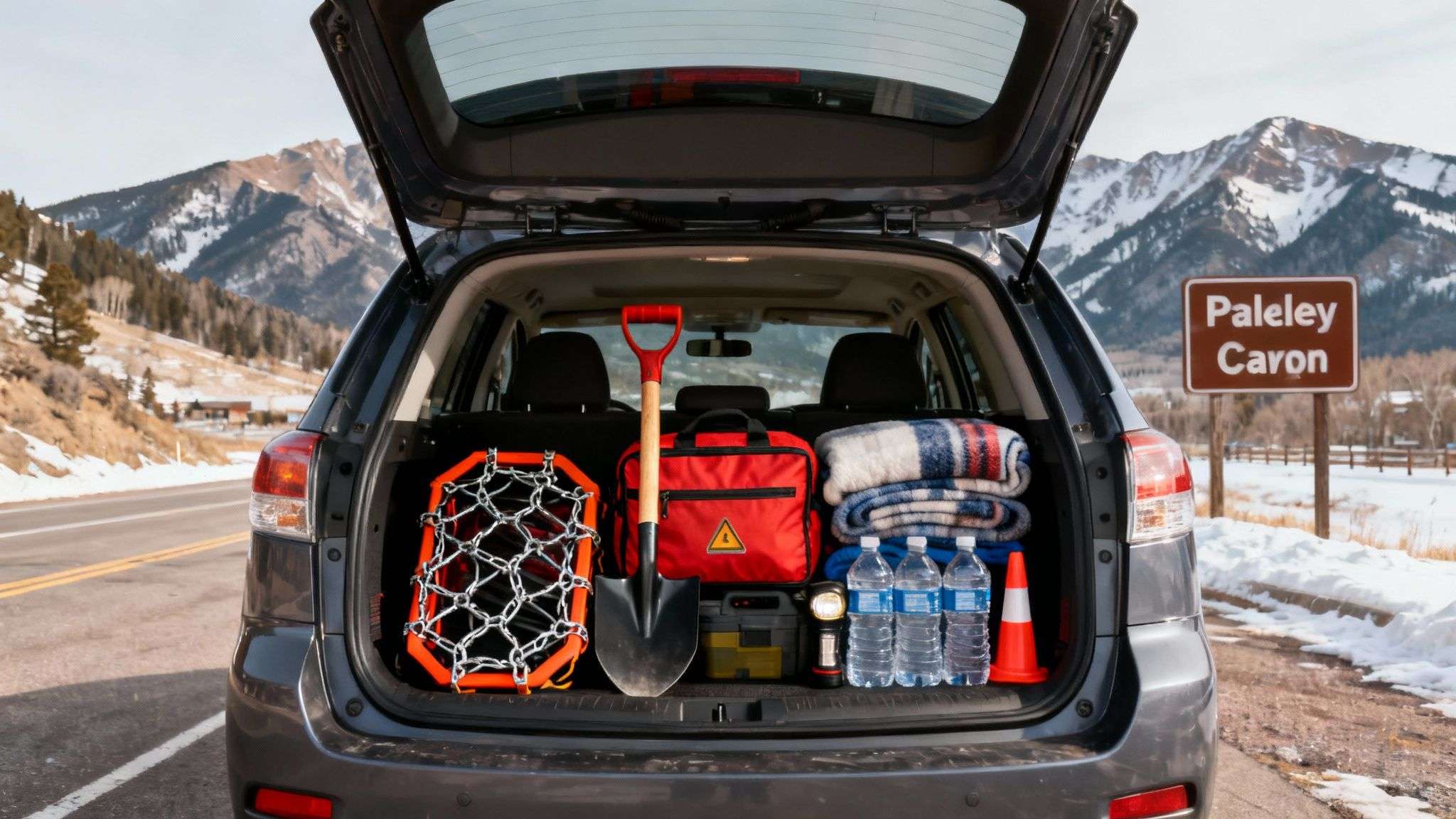A Driver's Guide to Weather in Parleys Canyon
Driving Parleys Canyon? Understand the unpredictable weather, from winter snowstorms to summer thunderstorms. Learn how to check real-time road conditions on I-80 for a safe trip.
Driving I-80 through Parleys Canyon means navigating one of Utah's most unpredictable weather corridors, where sunny skies in Salt Lake City can become a full-blown blizzard at the summit in minutes. Understanding the canyon's unique microclimate and knowing how to check real-time road conditions are essential for a safe trip, especially during winter. This guide breaks down what to expect each season and provides actionable tips for your drive.
What is the Weather Like in Parleys Canyon?

The weather in Parleys Canyon operates on its own terms, often defying the forecast for the Salt Lake Valley below. Its high elevation and mountain geography create intense, localized storms that can appear with little warning. This is due to a process called orographic lift, where the Wasatch Mountains force moist air upward, causing it to cool and release precipitation as rain or snow.
The summit, sitting at 7,120 feet, is the primary trigger point for these weather events. This single phenomenon explains why you can leave the mouth of the canyon in sunshine and drive into a whiteout blizzard minutes later. Conditions in Parleys can also be drastically different from those in nearby Little Cottonwood Canyon or Big Cottonwood Canyon.
When Does Parleys Canyon Get Bad Weather?
Every season brings unique challenges to I-80, but winter is when Parleys Canyon earns its reputation for hazardous travel. The shoulder seasons, spring and fall, are often the most deceptive, mixing warm sunshine with surprise snow squalls.
Parleys Canyon Seasonal Weather at a Glance
This table breaks down the typical conditions you’ll face and the primary hazards to watch for on the road. Remember, these are averages; the canyon can defy expectations, so always check the live forecast.
| Season | Average Temperature Range (High/Low) | Common Precipitation | Primary Driving Hazard |
|---|---|---|---|
| Winter | 15°F / 35°F (-9°C / 2°C) | Heavy Snow, Sleet | Black Ice, Low Visibility |
| Spring | 30°F / 55°F (-1°C / 13°C) | Rain, Wet Snow, Slush | Late-Season Blizzards |
| Summer | 55°F / 80°F (13°C / 27°C) | Rain, Hail | Thunderstorms, Hydroplaning |
| Autumn | 35°F / 60°F (2°C / 16°C) | Rain, Early Snow | Fog, Sudden Icy Patches |

- Winter: The biggest threat is heavy, lake-effect snow that causes whiteouts and slick roads. Black ice is a constant danger, especially in shaded curves and on bridges.
- Spring: A mix of slushy, wet, and icy patches is common as snow melts and refreezes. Be prepared for surprise late-season storms, even when the valley is warm.
- Summer: Intense afternoon thunderstorms can unleash torrential rain and hail, causing hydroplaning and reducing visibility to near zero.
- Autumn: Cooler nights bring dense fog and early morning frost on the road, creating unexpectedly slick conditions.
For more detail on these patterns, you can explore the historical weather patterns of Parleys Summit.
How to Prepare for Driving Through Parleys Canyon

Safe travel through Parleys Canyon requires checking conditions before you leave and ensuring your vehicle is ready for the drive. A general forecast is not enough; you need real-time, canyon-specific information.
Step 1: Check Live Road and Weather Conditions
Before you get in the car, consult these two critical resources:
- UDOT Traffic: The Utah Department of Transportation (UDOT) website and app provide live camera feeds, traffic speeds, accident reports, and official information on road closures and traction laws. This is your ground truth for what is happening on I-80 right now. For a complete overview, see our guide to UDOT road conditions in Utah.
- Hyper-Local Weather Forecasts: Look up the forecast specifically for "Parleys Summit," not just Salt Lake City or Park City. This will give you a more accurate prediction that accounts for high-elevation mountain effects.
Step 2: Ensure Your Vehicle is Ready
Your vehicle is your first line of defense. Proper tires are the most critical safety component for mountain driving.
- Tires: In winter, dedicated snow tires or at least M+S (Mud and Snow) rated tires are essential. Standard all-season tires lose grip below 45°F. Be prepared to comply with Utah's traction law, which may require 4WD/AWD or chains.
- Emergency Kit: Pack a kit with blankets, water, snacks, a flashlight, and a first-aid kit. A minor accident can shut down I-80 unexpectedly, and you could be stuck for hours.
Step 3: Drive for the Conditions
Mountain driving requires a defensive mindset.
- Slow Down: Posted speed limits are for ideal conditions. Reduce your speed significantly in snow, ice, or rain to maintain control, especially on steep downgrades.
- Increase Following Distance: Leave at least a four-second gap between you and the vehicle ahead. On slick roads, you need extra space to stop safely.
- Avoid Sudden Movements: Smooth, gradual steering, braking, and acceleration are key to preventing a skid.

Frequently Asked Questions
A few questions about driving Parleys Canyon come up often. Here are direct answers to help you plan.
Is Parleys Canyon Dangerous to Drive?
It can be, particularly during winter storms or summer downpours. The combination of steep 6% grades, sharp curves, and rapidly changing weather creates significant driving challenges. However, the route is generally safe if you are prepared. Always check real-time conditions, ensure your vehicle has appropriate tires, and adjust your speed to match the weather.
When Does Parleys Canyon Close?
Complete closures of I-80 through Parleys are rare. More common are temporary shutdowns lasting from 30 minutes to a few hours, typically caused by major accidents, avalanche control work, or extreme blizzard conditions where visibility drops to zero.
For the most current travel times and live camera feeds for your mountain adventures, rely on Wasatch Travel Helper. Get the real-time data you need before you go at https://wasatchroads.com.